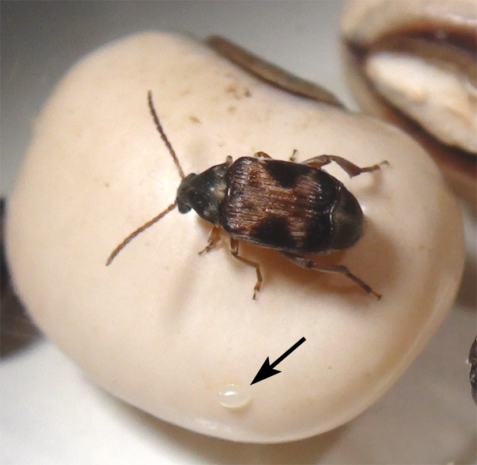Learn all about callosobruchus maculatus life cycle, oviposition, bean preference and economic importance.
Callosobruchus maculatus (Coleoptera: Chrysomelidae: Bruchinae), are agricultural pest insects of Africa and Asia that presently range throughout the tropical and subtropical world. This species also is known as the southern cowpea weevil.
The larvae of this species feed and develop exclusively on the seed of legumes (Fabaceae) hence the name bean beetle. The adults do not require food or water and spend their limited lifespan (one – two weeks) mating and laying eggs on beans.
The systematic placement of bean beetles is as follows: Callosobruchus is one of the genera in the subfamily Bruchinae (seed beetles) that is in the family Chrysomeloidae. This group is part of the order of beetles, Coleoptera (from Greek “sheath-winged” referring the stiff outer, first pair of wings (elytra) that protect the membranous second pair of flight wings). The Coleoptera is largest of the orders that comprise the class Insecta. Insects are the largest and most diverse (750,000 described species) of all the animal classes that are found in all but marine environments.
Insects are protostomous animals and are thus more closely related to mollusks and crustacea than to the deuterstomous vertebrate classes. See the Integrated Taxonomic Information System on the subfamily Bruchinae for more information on the systematic placement of Callosobruchus. The systematic placement of seed beetles in the family Chrysomelidae (rather than in their own family) is relatively recent so some websites on animal taxonomy may not yet reflect this change.
What is Callosobruchus Maculatus?
Callosobruchus maculatus is a species of beetles known commonly as the cowpea weevil or cowpea seed beetle. The body of the adult is 3-4.5 mm long, reddish-brown, with black spots on the prothorax and elytra. The last segment of the abdomen extends out from under the short elytra, and also with black spots. The females are sometimes larger and darker than the males. This pest has two forms, one flightless, the other a flying form. The larva is whitish.
Callosobruchus Maculatus Life Cycle
Once inseminated, adult females will lay (oviposit) single fertilized eggs on the external surface of a bean. Individual eggs (0.75mm long) are oval or spindle shaped, clear, shiny and firmly glued to the bean surface. The female cements its eggs (up to 200) on the surfaces of legume seedpods or seeds in the field or in storage. The larvae burrow into the seeds where their entire development (four instars plus pupal stadium) is completed. The larvae cannot move among seeds, thus restricted to the seed that their mother has chosen for them.
They pupate there, emerging as reproductively mature adults that are well adapted to storage conditions, requiring neither food nor water to reproduce. The threshold of development is at 14°C and 435 day degrees are required for the completion of a generation. A complete life cycle takes 4-5 weeks and there may be 6-7 overlapping annual generations. The beetles live only for 1-2 weeks.
Callosobruchus Maculatus Oviposition
The oviposition behavior of Callosobruchus maculates F. consists of three phases: patrolling of seed surfaces, preparation of the chosen oviposition site with glue, and egg deposition. An egg-marking pheromone is deposited with the egg. Disturbance of the oviposition sequence by courting males is likely to occur near its onset, but is less likely in later phases. This suggests that females nearing emission of the egg are programmed to complete the process.
Callosobruchus Maculatus Bean Preference
The reproductive success of Callosobruchus maculatus Fabricius, the main insect pest of stored cowpea, may vary between strains of this beetle and between varieties of the host seeds. Life history parameters of beetle strains from three different origins in West Africa were compared on two susceptible varieties of cowpea, Vigna unguiculata Walp. All beetle strains were assayed in a no-choice and a two-choice test. No major differences were found between the beetle strains.
In a no-choice situation, the developmental period from egg to adult was prolonged on the bean variety Kpodjiguegue. In a two-choice situation, the beetles showed a strong preference for the Californian blackeyed bean variety to oviposit on. Here again the development took longer on Kpodjiguegue beans and the intrinsic rate of increase of the beetle population was lower. Using either equal numbers of beans of the same size or equal weights of beans of undetermined size of the two bean varieties did not affect the outcome of the test.
Callosobruchus Maculatus Economic Importance
Callosobruchus maculatus is economically important as it damage to lentils, especially if stored for extended periods, may reduce their germination capacity by up to 80%. Infestations can start in the fields or in storage.



